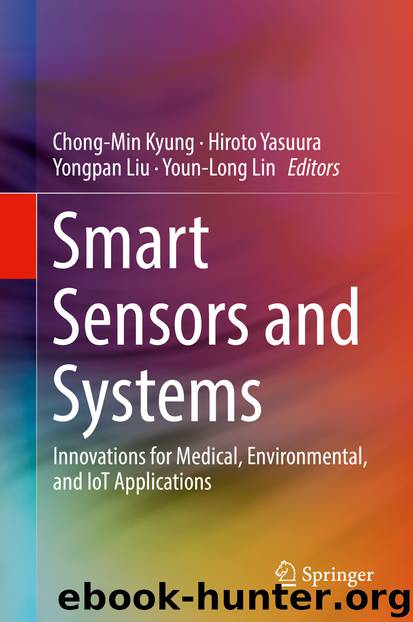Smart Sensors and Systems by Chong-Min Kyung Hiroto Yasuura Yongpan Liu & Youn-Long Lin

Author:Chong-Min Kyung, Hiroto Yasuura, Yongpan Liu & Youn-Long Lin
Language: eng
Format: epub
Publisher: Springer International Publishing, Cham
10.4.1 Digital Filtering
Digital filters are central to all signal processing systems. Each sample of the digitized signal is passed through a specific type of filter. Digital filters are used to filter out unwanted noise or artifacts from the biosignal to enhance the quality of the signal and prepare it for closed-loop detection.
If input data x[n] enter the filter sequentially, the output data y[n] is the weighted sum of the current and past values, and is given by:
where x[n−i] is the past input data, y[n−i] is the past output data, the a i and b i parameters are the weights, and M and N are the numerical data lengths. The filtered output data have the same number of samples, in which the first sample of y[n] corresponds to the first sample of x[n]. Filters that depend on current and past data are known as causal filters. In real-time applications, causal filtering is necessary because future input and output data are not yet available. A simple example is the computation of a moving average. When computing a moving average, the signal passes through the filter, and the filter data is equal to the sum of the past input samples (N) each weighted by 1/N. This filter attenuates the high frequencies and preserves the low frequencies. The guidelines for developing closed-loop control demand low complexity and short latency. The sums of the past N consecutive samples have to be considered in the optimal range.
Download
This site does not store any files on its server. We only index and link to content provided by other sites. Please contact the content providers to delete copyright contents if any and email us, we'll remove relevant links or contents immediately.
| Automotive | Engineering |
| Transportation |
Whiskies Galore by Ian Buxton(41514)
Introduction to Aircraft Design (Cambridge Aerospace Series) by John P. Fielding(32876)
Small Unmanned Fixed-wing Aircraft Design by Andrew J. Keane Andras Sobester James P. Scanlan & András Sóbester & James P. Scanlan(32560)
Craft Beer for the Homebrewer by Michael Agnew(17920)
Turbulence by E. J. Noyes(7684)
The Complete Stick Figure Physics Tutorials by Allen Sarah(7127)
Kaplan MCAT General Chemistry Review by Kaplan(6572)
The Thirst by Nesbo Jo(6425)
Bad Blood by John Carreyrou(6261)
Modelling of Convective Heat and Mass Transfer in Rotating Flows by Igor V. Shevchuk(6216)
Learning SQL by Alan Beaulieu(6017)
Weapons of Math Destruction by Cathy O'Neil(5807)
Man-made Catastrophes and Risk Information Concealment by Dmitry Chernov & Didier Sornette(5632)
Digital Minimalism by Cal Newport;(5364)
Life 3.0: Being Human in the Age of Artificial Intelligence by Tegmark Max(5169)
iGen by Jean M. Twenge(5145)
Secrets of Antigravity Propulsion: Tesla, UFOs, and Classified Aerospace Technology by Ph.D. Paul A. Laviolette(4965)
Design of Trajectory Optimization Approach for Space Maneuver Vehicle Skip Entry Problems by Runqi Chai & Al Savvaris & Antonios Tsourdos & Senchun Chai(4833)
Electronic Devices & Circuits by Jacob Millman & Christos C. Halkias(4731)
